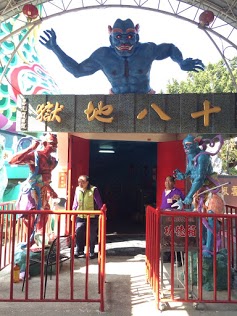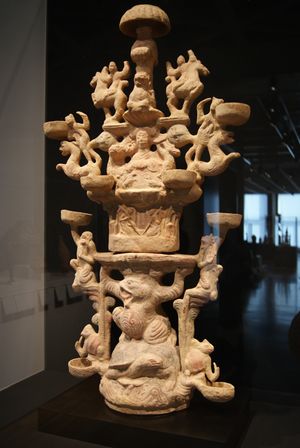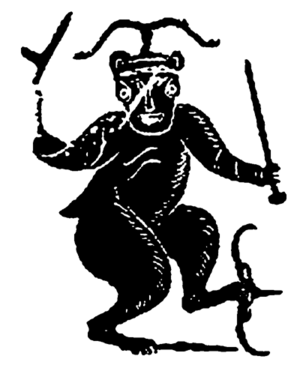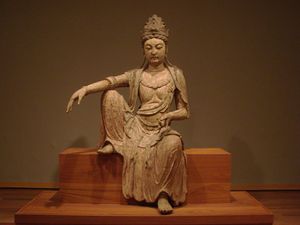الأساطير الصينية

| جزء من سلسلة عن |
| الديانة الشعبية الصينية |
|---|
 |
| بوابة الديانة الشعبية الصينية |
Chinese mythology (Chinese: 中國神話; pinyin: Zhōngguó shénhuà) is mythology that has been passed down in oral form or recorded in literature in the geographic area now known as "China". Chinese mythology includes many varied myths from regional and cultural traditions. Chinese mythology is far from monolithic, not being an integrated system, even among just Han people. Chinese mythology is encountered in the traditions of various classes of people, geographic regions, historical periods including the present, and from various ethnic groups. China is the home of many mythological traditions, including that of Han Chinese and their Huaxia predecessors, as well as الأساطير التبتية و الأساطير التوركية والأساطير الكورية, and many others. However, the study of Chinese mythology tends to focus upon material in Chinese language.
Mythology and ritual
Mythology exists in relationship with other aspects of society and culture, such as ritual. Various rituals are explained by mythology. For example, the ritual burning of mortuary banknotes (Hell Money), lighting fireworks, and so on.
قصة الخلق عند الصينيين - بداية الثقافة - الخمر وعصى الأكل - الاباطرة الافاضل - ملك كافر
تسمى الصين "جنة المؤرخين"؛ ذلك أنها ظلت مئات وآلافا من السنين ذات مؤرخين رسميين يسجلون كل ما يقع فيها، وكثيرا مما لا يقع. على أننا لا نثق بأقوالهم عن العهود السابقة لعام 76 ق. م، ولكننا اذا استمعنا إلى هذه الاقوال رأيناهم يحدثوننا أحاديث مفصلة عن تاريخ الصين منذ 3000 ق. م، ورأينا أكثرهم تقى وصلاحا يصفون خلق العالم كما يفعل المطلعون على الغيب في هذه الايام. ومن أقوالهم في هذا أن "بان كو" أول الخلائق استطاع أن يشكل الأرض حوالي عام 2.229.000 ق.م بعد أن ظل يكدح في عمله هذا ثمانية عشر ألف عام. وتجمعت أنفاسه التي كان يخرجها في أثناء عمله فكانت رياحا وسحبا، وأضحى صوته رعدا، وصارت عروقه أنهارا، واستحال لحمه أرضا، وشعره نبتا وشجرا، وعظمه معادن، وعرقه مطرا؛ أما الحشرات التي كانت تعلق بجسمه فأصبحت آدميين. وليس لدينا من الادلة القاطعة ما ننقض به هذا العلم الكوني العجيب.
وتقول الاساطير الصينية ان الملوك الاولين حكم كل منهم ثمانية عشر ألف عام، وأنهم جاهدوا أشق جهاد ليجعلوا من قمل "بان كو" خلائق متحضرين. وتقول لنا هذه الاساطير ان الناس "كانوا قبل هؤلاء الملوك السماويين كالوحوش الضارية يلبسون الجلود ويقتاتون باللحوم النيئة، ويعرفون أمهاتهم، ولكنهم لا يعرفون آباءهم"- ولا يرى سترندبرگ strendberg أن هذا الوصف الاخير مقصور على الأقدمين أو على الصينيين.
ثم جاء من بعد هؤلاء الامبراطور فوشي في عام 852 ق. م بالتحديد، فعلم الناس بمعاونة زوجه المستنيرة الزواج، والموسيقى والكتابة والتصوير، وصيد السمك بالشباك، وتأنيس الحيوان، واطعام دود القز للحصول منها على الحرير. وأوصى وهو على فراش الموت أن يخلفه سن نونج، فأدخل هذا الامبراطور في البلاد الزراعة، واخترع المحراث الخشبي، وأقام الاسواق وأوجد التجارة، وأنشأ علم الطب بما عرفه من خواص النبات العلاجية، هذا ما تقوله الاساطير التي تعلي الاشخاص أكثر مما تعلي الافكار، وتعزو إلى عدد قليل من الافراد نتائج كدح الاجيال الطوال.
ثم حكم امبراطور محارب قوى يدعى هوانج-دي لم يطل عهده أكثر من مائة عام، فجاء إلى الصين بالمغنطيس والعجلات، ووظف المؤرخين الرسميين، وشاد أول أبنية من الآجر في الصين؛ وأقام مرصدا لدراسة النجوم، وأصلح التقويم، وأعاد توزيع الأرض على الأهلين.
يوبو
A good example of the relationship of Chinese mythology and ritual is the Yubu, also known as the Steps or Paces of يو. During the course of his activities in controlling the Great Flood, Yu was supposed to have so fatigued himself that he lost all the hair from his legs and developed a serious limp. Daoist practitioners sometimes incorporate a curiously choreographed pedal locomotion into various rituals. Mythology and practice, one explains the other: in these rituals, the sacred time of Yu merges with the sacral practice of the present.
وحكم "ياو" قرنا آخر، وبلغ من صلاح حكمه أن كنفوشيوس، حين كتب عنه بعد زمانه بثمانمائة وألف عام في عهد كان يبدو له بلا ريب عهدا "حديثا" فاسدا، أخذ يندب ما طرأ على الصين من ضعف وانحلال. ويحدثنا الحكيم القديم- الذي لم يستطع رغم حكمته التورع عن "الكذبة الصالحة" يضيفها إلى القصة ليجعل لها مغزى خلقيا- يحدثنا هذا الحكيم القديم أن الناس أصبحوا أفاضل أتقياء بمجرد النظر إلى "ياو"، وكان أول ما قدمه "ياو" من معونة للمصلحين أن وضع في خارج باب قصره طبلا يضربونه اذا أرادوا أن يدعوه لسماع شكواهم ولوحا يكتبون عليه ما يشيرون به على الحكومة ويقول كتاب سجلات المؤرخ العظيم ذائع الصيت:
| "أما ياو الصالح فيقولون عنه انه حكم ژونگ گوو مائة عام لأنه عاش مائة عام وعشرة وستة؛ وكان رحيما خيرا كالسماء، حكيما بصيرا كالآلهة، وكان ضياؤه يبدو من بعيد كالسحابة اللامعة، فاذا اقتربت منه كان كأنه الشمس الساطعة. وكان غنيا في غير زهو، عظيما في غير ترف وكان يلبس قلنسوة صفراء، ومئزرا قاتم اللون، ويركب عربة حمراء تجرها جياد بيض. وكانت طنف أسقف بيته غير مشذبة، وألواحه غير مسحجة، ودعائمه الخشبية غير ذات أطراف مزينة.
وكان أغلب ما يقتات به الحساء أيا كان ما يصنع منه، لا يهتم باختيار الحبوب التي يصنع منها خبزه، وكان يشرب حساء العدس من صفحة مصنوعة من الطين، ويتناوله بملعقة من الخشب. ولم يكن يتحلى بالجواهر، ولم تكن ثيابه مطرزة، بل كانت بسيطة لا يختلف بعضها عن بعض. ولم يكن يعني بغير المألوف من الاشياء أو الغريب من الاحداث، ولم يكن يقيم وزنا للأشياء النادرة الغريبة، يستمع لأغاني الغزل، عربته الرسمية خالية من أسباب الزينة... يلبس في الصيف رداء بسيطا من القطن، ويلف جسمه في الشتاء بجلود الظباء. ومع هذا كله فقد كان أغنى من حكم ژونگ گوو، طوال عهدها كله، وأرجحهم عقلا، وأطولهم عمرا، وأحبهم إلى قلوب الشعب. |
وكان شون آخر هؤلاء "الملوك الخمسة" مثالا في البر البنوي، كما كان هو البطل الذي جاهد لحماية البلاد من فيضانات نهر هوانج-هو، والذي أصلح التقويم، وضبط الموازين والمقاييس، وكسب محبة الاجيال التي جاءت بعده من تلاميذ المدارس بتقصير طول السوط الذي كانوا يربون به.
وتقول الروايات الصينية إن شون في آخر أيامه رفع معه على العرش أقدر مساعديه، وهو المهندس العظيم يو، الذي تغلب على فيضان تسعة أنهار بشق تسعة جبال واحتفار تسع بحيرات، ويقول الصينيون "لولا يو، لكنا كلنا سمكا". وتقص الأساطير المقدسة أن نبيذ الأرز عصر في أيامه وقدم للامبراطور، ولكن "يو" صبه على الارض وقال متنبئا: "سيأتي اليوم الذي يخسر فيه أحد الناس بسبب هذا الشيء ملكا"، ثم نفي من كشف هذا الشرب من البلاد وحرم على الناس شربه. فلما فعل هذا جعل الناس خمر الأرز شرابهم القومي، فكان ذلك درسا علموه لمن جاء بعدهم من الخلائق.
وغيّر يو المبدأ الذي كان متبعا من قبله في وراثة الملك وهو أن يعين الامبراطور قبل وفاته من يخلفه على العرش، فجعل الملك وراثيا في أسرته، وأنشأ بذلك أسرة الشيتية (أي المتحضرة)، فكان ذلك سببا في أن يتعاقب على حكم الصين العباقرة والبلهاء وذوو المواهب الوسطى. وقضى على هذه الاسرة امبراطور ذو أطوار شاذة، يدعى جية أراد أن يسلي نفسه هو وزوجته فأمر ثلاثة آلاف من الصينيين أن يموتوا ميتة هنيئة بالقفز في بحيرة من النبيذ.
وليس لدينا ما يحقق لنا صدق ما ينقله إلينا المؤرخون الصينيون الأقدمون من أخبار هذه الاسرة. وكل ما نستطيع أن نقوله أن علماء الفلك في هذه الأيام قد حققوا تاريخ الكسوف الشمسي الذي ورد ذكره في السجلات القديمة فقالوا إنه قد حدث في عام 2165 ق.م.، ولكن الثقاة الذين يعتد بآرائهم لا يؤمنون بحساب أولئك الفلكيين(16). وقد وجدت على بعض العظام التي كشفت في هونان أسماء حكام تعزوهم الروايات الصينية إلى الاسرة الثانية أو أسرة شانگ؛ ويحاول المؤرخون أن يعزوا بعض الأواني البرونزية الموغلة في القدم إلى أيام تلك الأسرة. أما فيما عدا هذا فمرجعنا الوحيد هو القصص الذي يحوي من الطرافة واللذة أكثر مما يحوي من الحقيقة. وتقول الروايات القديمة إن وو يي أحد أباطرة أسرة شانگ كان كافرا يتحدى الآلهة ويسب روح السماء، ويلعب الشطرنج مع ذلك الروح ويأمر أحد أفراد حاشيته بأن يحرك القطع بدل الروح، فإذا أخطأ سخر منه. ثم أهدى اليه كيساً من الجلد وملأه دماً، وأخذ يسلي نفسه بأن يصوب إليه سهامه. ويؤكد لنا المؤرخون- وفيهم من الفضيلة أكثر مما في التاريخ نفسه- أن وو-يي أصابته صاعقة فأهلكته.
وكان ژو شين آخر ملوك هذه الأسرة ومخترع عصى الطعام خبيثا آثما إلى حد لا يكاد يصدقه العقل، فقضى بإثمه على أسرته. ويحكى عنه أنه قال: "لقد سمعت أن لقلب الانسان سبع فتحات، وأحب أن أتثبت من صدق هذا القول في بي كان"- وزيره وكانت تاكي زوجة جو مضرب المثل في الفجور والقسوة، فكانت تعقد في بلاطها حفلات الرقص الخليع، وكان الرجال والنساء يسرحون ويمرحون عارين في حدائقها. فلما غضب الناس من هذه الفعال عمدت إلى كم أفواههم باختراع ضروب جديدة من التعذيب، فكانت ترغم المتذمرين على أن يمسكوا بأيديهم معادن محمية في النار أو يمشوا على قضبان مطلية بالشحم ممتدة فوق حفرة مملوءة بالفحم المشتعل، فإذا سقط الضحايا في الحفرة طربت الملكة حين تراهم تشوى أجسادهم في النار.
وقضت على عهد ژو شين مؤامرة دبرها الثوار في داخل البلاد، وغارة من ولاية ژو الغربية، ورفع المغيرون على العرش أسرة ژو، وقد دام حكمها أطول من حكم أية أسرة مالكة أخرى في بلاد الصين. وكافأ الزعماء المنتصرون من أعانوهم من القواد والكبراء بأن جعلوهم حكاما يكادون أن يكونوا مستقلين في الولايات الكثيرة التي قسمت اليها الدولة الجديدة. وعلى هذا النحو بدأ عهد الاقطاع الذي كان فيما بعد شديد الخطر على حكومة البلاد، والذي كان رغم هذا باعثا على النشاط الأدبي والفلسفي في بلاد الصين. وتزاوج القادمون الجدد والسكان الأولون وامتزجوا جميعا، وكان امتزاجهم هذا تمهيدا بيولوجيا لأولى حضارات الشرق الأقصى في الازمنة التاريخية.
علم الكون
عالم السماء
عالم ما تحت الأرض
الجبال وما يتخللها
كونلون
أسطورة الوقت والتقويم
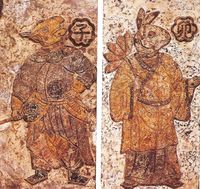
Mythology of time and the calendar includes the twelve zodiacal animals and various divine or spiritual genii regulating or appointed as guardians for years, days, or hours.
حيوانات الأبراج الإثناعشر
In China and surrounding areas, a calendrical system consisting of measuring time in cycles of twelve represented by twelve has an ancient historical past. The exact line-up of animals is sometimes slightly different, but the basic principle is that each animal takes a turn as the emblematic or totem animal for a year or other unit of time in a cycle of one dozen. This is explained by various myths.
الربط بين الزمن الأسطوري والزمن الحقيقي
أساطير الخلق
Various ideas about the creation of the universe, the earth, the sky, various deities and creatures, and the origin of various clans or ethnic groups of humans have circulated in the area of China for millennia. These creation myths may include the origins of the universe and everything, the origins of humans, or the origins of specific groups, such as a Han Chinese in descent from Yandi and Huangdi (as 炎黃子孫, "Descendants of the Flame and Yellow Emperors"). Various myths contain explanations of various origins and the progress of cultural development.
پانگو
One common story involves پانگو. Among other sources, he was written about by Taoist author Xu Zheng c. 200 CE, as claimed to be the first sentient being and creator, "making the heavens and the earth" (Werner 1922, p. 77).
عصر الأبطال
Various culture heroes have been said to have helped or saved humanity in many ways, such as stopping floods, teaching the use of fire, and so on. As mythic chronology is inherently nonlinear, with time being telescopically expanded or contracted, and with various contradictions. The earliest culture heroes were sometimes considered deities sometimes heroic humans, sometimes considered to be heroic humans, and often little distinction was made. Examples of early culture heroes include Youchao ("Have Nest") who taught people how to make wooden shelters (Wu 1982, p. 51; Christie 1968, p. 84), Suiren ("Fire Maker") who taught people the use of fire and cooking thus saving them from much food-poisoning together with progress toward development of cuisine (Wu 1982, p. 51; Christie 1968, p. 84). Another example of a mythological hero who provided beneficial knowledge to humanity involves sericulture, the production of silk: an invention credited to Leizu, for one. An example of a non-Han ethnicity culture hero is Panhu. Because of their self-identification as descendants from these original ancestors, Panhu has been worshiped by the Yao people and the She people, often as King Pan, and the eating of dog meat tabooed (Yang, An & Turner 2005, pp. 52–53). This ancestral myth is also has been found among the Miao people and Li people (Yang, An & Turner 2005, pp. 100 and 180). Some of the first culture heroes are the legendary emperors who succeeded the times of the part human part serpent deities Nuwa and Fuxi; these emperors tend to be portrayed as more explicitly human, although Huangdi, the Yellow Emperor, is often portrayed as part dragon during life.
الأباطرة الأسطوريون
هوجي
Houji was a cultural hero, of the agricultural type. (Birrell 1993, pp. 54–58)
Chiyou
Chiyou (also known as Ch'ih Yu) was a metallurgical engineer, specializing in weaponry.(Birrell 1993, pp. 50–53)
Three Primeval Emperors, Five Premier Emperors, and Three Dynasties
Nuwa and Fuxi
Nuwa and Fuxi (also known as Paoxi) are sometimes worshiped as the ultimate ancestor of all humankind and are often represented as half-snake, half-humans. Her companion, Fuxi, also called Fu Hsi and Paoxi was her brother and husband.
Nuwa saves the world
After Gong-Gong was said to have damaged the world pillar holding the earth and sky apart, the sky was rent causing fires, floods (the Flood of Nuwa) and other devastating events which were only remedied when Nuwa repaired the sky with five colored stones. (Also referred to as Nü Kwa) appeared in literature no earlier than c. 350 BCE. It is sometimes believed that Nüwa molded humans from clay to populate or re-populate the world, thus creating modern humans.
Fuxi and the Yellow River map
The production of the Yellow River Map is associated mythologically with Fuxi but is also sometimes placed in subsequent eras.
Important deities, spirits, and mythological people

There are various important deities, spirits, and mythological people in Chinese mythology and folk religion. Some are clearly divine, such as the Jade Emperor (and even he is sometimes said to have begun life as a mortal). However, in Chinese language many beings are referred to as shen. (Sometimes Chinese mythology is called 中國神話 – Mandarin Chinese: Zhōngguó Shénhuà). Due to the ambiguity of this word when translated into English, it is not always clear how to classify in English the entities described shen (not to be confused with the mythological clam). The category shen is rather comprehensive and generic in Chinese myth and religion, shen may be spirits, goddesses or gods, ghosts, or other. Another important concept is the classification of immortals (xian). Immortals are more a category of quality than a description of an actual type. Immortals are defined by living for a long time (maybe forever). However, this is not a static quality, since Daoist adepts, shamans, or others are said to become immortals through right effort and various practices. Another example is the immortality sometimes obtained by the lohans, Bodhisattvas, and Buddhas of Buddhist religion and mythology (this contrasts with indefinitely prolonged series of unenlightened re-births). Chinese mythology often tends to not make a clear differentiation between Buddhist and Daoist types. Various deities, spirits, and immortals (xian) are encountered in various myths. Some of these are particularly associated with Daoism. Some immortals or others became incorporated into Daoism as it developed as a phenomenon, deriving from ancient shamanic cults or other sources. The line between Daoism and folk religion is not clear. Other mythological beings are clearly derived through the process of the introduction of Buddhism into China.
Major deities
The concept of a principal or presiding deity has fluctuated over time in Chinese mythology.
Shangdi
Shangdi, also sometimes Huángtiān Dàdì (皇天大帝), appeared as early as the Shang dynasty. In later eras, he was more commonly referred to as Huángtiān Shàngdì (皇天上帝). The use of Huángtiān Dàdì refers to the Jade Emperor and Tian.
Jade Emperor
Chinese mythology holds that the Jade Emperor was charged with running of the three realms: heaven, hell, and the realm of the living. The Jade Emperor adjudicated and meted out rewards and remedies to saints, the living, and the deceased according to a merit system loosely called the Jade Principles Golden Script (玉律金篇, Yù lǜ jīn piān). When proposed judgments were objected to, usually by other saints, the administration would occasionally resort to the counsels of advisory elders. The Jade Emperor appeared in literature after the establishment of Taoism in China; his appearance as Yu Huang dates back to beyond the times of Yellow Emperor, Nüwa, or Fuxi.
Tian
Tian can be either a sky deity by that name or Heaven – the Sky itself. Tian appeared in literature c. 700 BCE, possibly earlier as dating depends on the date of the Shujing (Book of Documents). There are no creation-oriented narratives for Tian. The qualities of Tian and Shangdi appear to have merged in later literature and are now worshiped as one entity ("皇天上帝", Huángtiān Shàngdì) in, for example, the Beijing's Temple of Heaven. The extent of the distinction between Tian and Shangdi is debated. The sinologist Herrlee Creel claims that an analysis of the Shang oracle bones reveals Shangdi to have preceded Tian as a deity, and that Zhou dynasty authors replaced the term "Shangdi" with "Tian" to cement the claims of their influence.
الطاوية والأساطير الصينية
Over time certain aspects of folk religion and belief coalesced and were refined into a group of formal religious beliefs, practices, and philosophy known as Daoism. One of the founders of Daoism was Old Man Laozi, who himself entered into legend or mythology. There is much overlap between religion and mythology, and between Chinese folk religion and Daoism. However, certain beings or concepts of Chinese mythology have a particularly strong association with religious or philosophical Daoism. For example, the Jade Emperor, Yùhuáng, is a major actor in many myths. In Daoist-related mythology there is often a strong presence of sorcery and magic, such as spells, charms, magical abilities, and elixirs. The development of Daoism as it came to be called was a lengthy one, with various strands including both rationalist ethical philosophy and a magico-religious stand informed by mythology. As Daoism developed as a concept from its traditional roots in Chinese folk religion and mythology, its legitimacy was bolstered by claims of originating with Huangdi, the Yellow Emperor (Ferguson 1928, p. 20). For example, the some of the Huangdi Sijing material, the Huangdi Yinfujing, and the Huangdi Neijing are Daoist classics with claims to a scriptural legacy going back to Huangdi.
- الأنقياء الثلاثة 三清 (الثلاثية الطاوية)
Jade Emperor
The Jade Emperor, Yùhuáng has had a long and very active mythology, including making the world safe for the people by ridding it of demons long ago, holding a race of various animals which determined the order of the twelve-year calendar cycle, and generally running various affairs on Earth and the Underworld from his abode in Heaven. Besides his active life in mythology, Yùhuáng is a major divinity of worship in modern Daoism.
الخالدون الثمانية
الخالدون الثمانية have an existence in mythology as well as developed a presence in religious Daoism, and art and literature. The standard group is He Xian'gu, Cao Guojiu, Li Tieguai, Lan Caihe, Lü Dongbin, Han Xiangzi, Zhang Guolao, and Han Zhongli (also known as Zhongli Quan). Collectively or individual the eight immortals walk, ride, fly, or congregate in many myths.
Buddhist influences
Buddhism was historically introduced to China, probably in the first century CE, accompanied by the import of various ideas about deities and supernatural beings including Kṣitigarbha who was renamed Dizang. the Four Heavenly Kings, the main Buddha himself Shakyamuni Buddha (釋迦牟尼佛, Shìjiāmóunífó), Avalokiteśvara who after a few centuries metamorphosized into Guanyin (also Kuanyin) a bodhisattva of compassion, and Hotei the Laughing Buddha. New Buddhist material continued to enter China, with a big spike in the Tang dynasty, when the monk Xuanzang brought over 600 texts from India (Schafer 1963, pp. 273–275) Over time, Guanyin also became a Daoist immortal and was the subject of much mythology.
Guanyin
المخلوقات الأسطورية
Non-divine mythological beings are sometimes divided into several parts each ruled over by a particular type of being—humans ruled over by the Emperor, winged creatures ruled over by the phoenix, and scaly, finned, or crawly creatures ruled over by the dragon. However, whatever the approach, mythological taxonomy is not a rigorous discipline, not even as clear as folk taxonomy, much less the scientific efforts which result in modern biological taxonomy. Often, mythological creatures inhabit the furthest reaches of the exotic imagination.
الأذكياء الأربعة
الأذكياء الأربعة were four species of animals of particular intelligence (not considering humans). Each one represented and ruled over a class of animals. The Four Intelligents were the dragon, the phoenix, the unicorn, and the tortoise. For example, Xu Shen's dictionary Shuowen Jiezi (under the entry for long, dragon) describes the dragon as: "Head of all animals that swim or crawl..." (Wu 1982, pp. 5–6).
التنينات وأشباهها والمخلوقات ذات الصلة
The Chinese dragon is one of the most important mythical creatures in Chinese mythology, considered to be the most powerful and divine creature and the controller of all waters who could create clouds with their breath. The dragon symbolized great power and was very supportive of heroes and gods. The conventional dragon has a certain description, however there are other dragons or dragon-like beings that vary from this description. For example, the Chi of mythology lacks horns. Dragons often chase or play with a mystical or flaming pearl. A dragon-fenghuang pairing is a common motif in art, the fenghuang often being called a "phoenix".
One of the most famous dragons in Chinese mythology is Yinglong, the god of rain. Many people in different places pray to Yinglong to receive rain. Chinese people use the term 龍的傳人 ("Descendants of the Dragon") as a sign of their ethnic identity. Shenlong is a master of storms and bringer of rain. Zhulong the Torch Dragon is a giant red solar deity. Sometimes he appears in composite snake-like, human-dragon form. There were various dragon kings. They mostly lived undersea and were of the Ao family, such as Ao Guang.
Various mythology accounting human-dragon relationships exist, such as the story of Longmu, a woman who raise dragons.
Specific dragons, or types of dragon, include: Dilong, the earth dragon; Fucanglong, the treasure dragon; Jiaolong, dragon of floods and sea; Teng, a flying creature, sometimes considered a type of snake or dragon-snake; Tianlong, the celestial dragon, sometimes associated with centipede qualities; Yinglong, the water dragon, a powerful servant of the Yellow Emperor.
The fourteenth monarch of the Xia dynasty is said to be Kong Jia, who, according to mythology, raised dragons. (Birrell 1993, pp. 60–61)
Fish and fish-like
Various mythology of China involves fish or fish-like beings. Part human, part sea creatures of the Mermaid (人魚) type appear. The Kun (or Peng) was a giant monstrous fish transformation of the Peng bird. Carp that leapt the dragon gate falls of the Yellow River were said to transform into dragons. This was used as a symbol for a scholar's successful graduation in the Imperial examination system.
Snakelike and reptilian
Birds
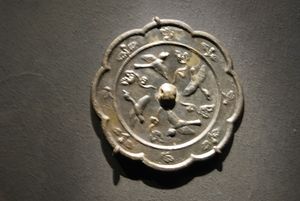
Four Fiends
The Four Fiends:
- Hundun: chaos
- Taotie: gluttony
- Táowù (梼杌): ignorance; provided confusion and apathy and made mortals free of the curiosity and reason needed to reach enlightenment
- Qióngqí (窮奇): deviousness
Miscellaneous or other
- Nian: lives under the sea or in mountains; attacks children
- Luduan: can detect the truth
- Xiezhi (also Xie Cai): the creature of justice said to be able to distinguish lies from truths; it had a long, straight horn used to gore liars
- Bai Ze: legendary creature said to have been encountered by the Yellow Emperor and to have given him a compendium listing all the demons in the world
المصادر الرئيسية
البرونزيات

Vernacular novels and new media
علم الأساطير المقارنة
Many insights have developed through the examination of Chinese mythology as part of the field of comparative mythology, which is the comparison of myths from different cultures in order to identify shared themes, motifs, or other features. Early exponents of comparative mythology which are informative to the study of Chinese mythology include Georges Dumézil and James Frazer (Birrell 1993, pp. 10–11).
في الثقافة الشعبية
Thousands of years of the development of Chinese mythology has resulted in Chinese mythology in popular culture, in the sense of popular culture affected or inspired by this tradition. This includes television shows, cinema, and video games. Also, many of the vehicles associated with the modern Chinese space program are named after mythology, such as the lunar explorer Chang'e 4 that achieved the first soft landing on the far side of the Moon, on 3 January 2019 (The Guardian, 2 January 2019), and named after the lunar goddess Chang'e associated and with a communications relay satellite Queqiao, named after the lovers bridge over the Milky Way formed by magpies.
انظر أيضاً
- Celestial bureaucracy
- Chinese astrology
- Chinese creation myth
- Chinese folk religion
- Chinese folklore
- Chinese legendary creatures
- Chinese mythology in popular culture
- Chinese spiritual world concepts
- Cicada#In human culture
- Dance of China
- I Ching
- Imperial examination in Chinese mythology
- Philippine mythology
- List of deities
- List of Chinese mythology: a list version of this Wikipedia article
- Lo Shu Square
- Music of China
- Panhu
- Sanxing (deities)
- Simians (Chinese poetry)
- Teng
- Weapons and armor in Chinese mythology
- Yuan Ke
References
- Barrett, T. H. (2008). The Woman Who Discovered Printing. New Haven: Yale University Press. ISBN 978-0-300-12728-7.
{{cite book}}: Invalid|ref=harv(help) - Birrell, Anne (1993). Chinese Mythology. Baltimore: Johns Hopkins. ISBN 0-8018-6183-7.
{{cite book}}: Invalid|ref=harv(help) - Christie, Anthony (1968). Chinese Mythology. Feltham: Hamlyn Publishing. ISBN 0600006379.
{{cite book}}: Invalid|ref=harv(help)CS1 maint: location missing publisher (link) - Eberhard, Wolfram (2003) [1986]. A Dictionary of Chinese Symbols: Hidden Symbols in Chinese Life and Thought. London, New York: Routledge. ISBN 0-415-00228-1.
{{cite book}}: Invalid|ref=harv(help) - Ferguson, John C. (1928). "China". Mythology of All Races. Vol. Volume VIII. Archeological Institute of America – via archive.org.
{{cite encyclopedia}}:|volume=has extra text (help); Invalid|ref=harv(help) - Hawkes, David (2011) [1985]. The Songs of the South: An Ancient Chinese Anthology of Poems by Qu Yuan and Other Poets. London, England: Penguin Books. ISBN 978-0-14-044375-2.
{{cite book}}: Invalid|ref=harv(help) - Latourette, Kenneth Scott (1947). The Chinese: Their History and Culture (3rd Revised ed.). New York: Macmillan.
{{cite book}}: Invalid|ref=harv(help) - Legge, James (1963) [1899]. The I Ching: The Book of Changes Second Edition. New York: Dover. LCCN 63-19508.
{{cite book}}: Invalid|ref=harv(help) - Paludan, Ann (1998). Chronicle of the Chinese Emperors: The Reign-by-Reign Record of the Rulers of Imperial China. New York, NY: Thames and Hudson. ISBN 0-500-05090-2.
{{cite book}}: Invalid|ref=harv(help) - Paper, Jordan D. (1995). The Spirits are Drunk: Comparative Approaches to Chinese Religion. Albany, NY: State University of New York Press. ISBN 0-7914-2315-8.
{{cite book}}: Invalid|ref=harv(help) - Schafer, Edward H. (1963). The Golden Peaches of Samarkand. Berkeley, CA: University of California Press.
{{cite book}}: Invalid|ref=harv(help) - Sheppard, Odell (1930). The Lore of the Unicorn — Myths and Legends. London: Random House UK. ISBN 0-09-185135-1.
{{cite book}}: Invalid|ref=harv(help) - Siu, R. G. H. (1968). ""Preface" and "Introduction"". The Man of Many Qualities: A Legacy of the I Ching. Cambridge: Michigan Institute of Technology Press. LCCN 68-18242.
{{cite book}}: Invalid|ref=harv(help) - Strassberg, Richard E., ed. (2018) [2002]. A Chinese Bestiary: Strange Creatures from the GUIDEWAYS THROUGH MOUNTAINS AND SEAS. Berkeley and Los Angeles, CA: University of California Press. ISBN 978-0-520-29851-4.
{{cite book}}: Invalid|ref=harv(help) - Werner, E.T.C. (1922). Myths and Legends of China. New York: George G. Harrap & Co. Ltd.
{{cite book}}: Invalid|ref=harv(help) - Wu, K. C. (1982). The Chinese Heritage. New York, CA: Crown Publishers. ISBN 0-517-54475X.
{{cite book}}: Invalid|ref=harv(help) - Yang, Lihui; An, Deming; Turner, Jessica Anderson (2005). Handbook of Chinese Mythology. New York, NY: Oxford University Press. ISBN 978-0-19-533263-6.
{{cite book}}: Invalid|ref=harv(help)

